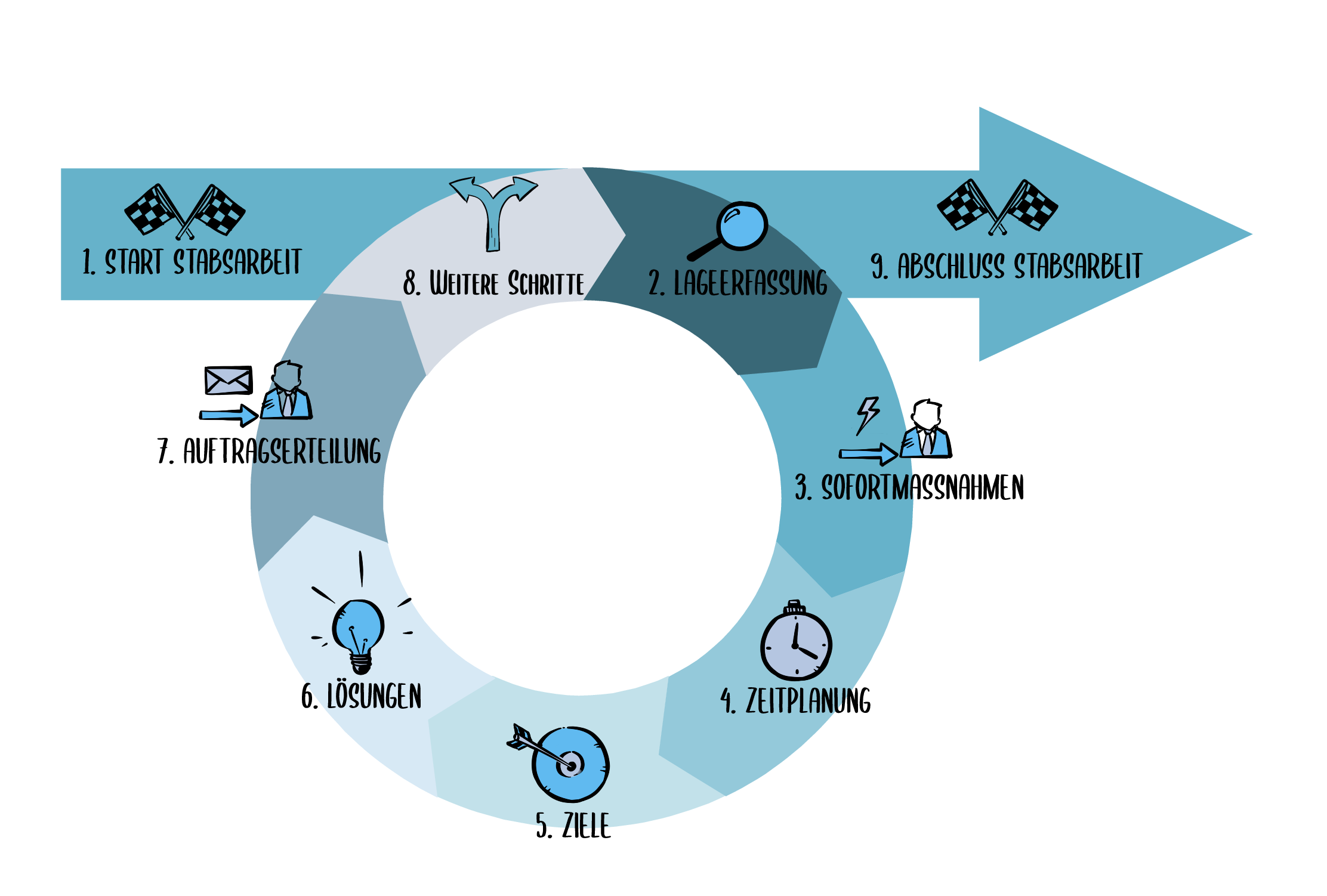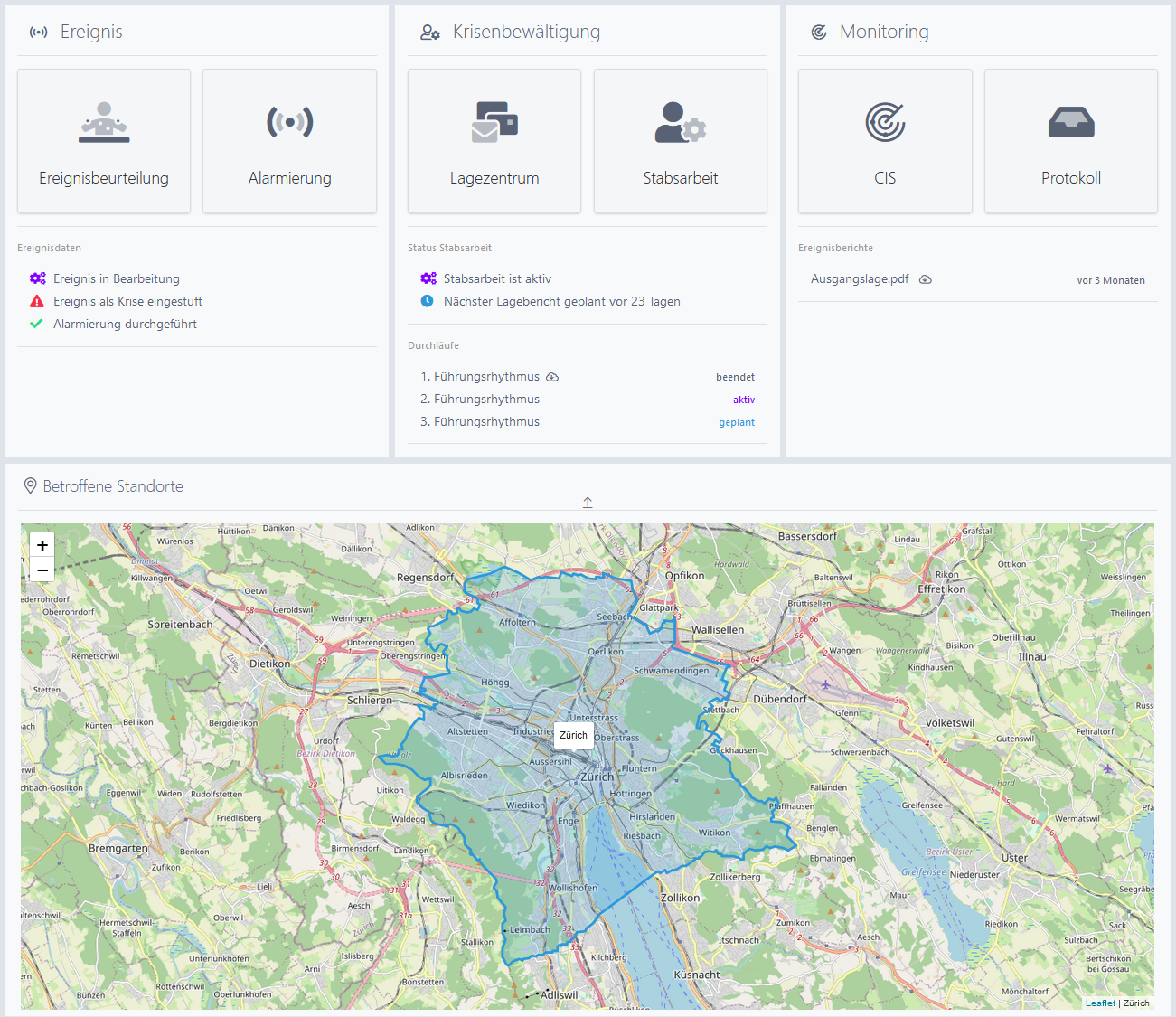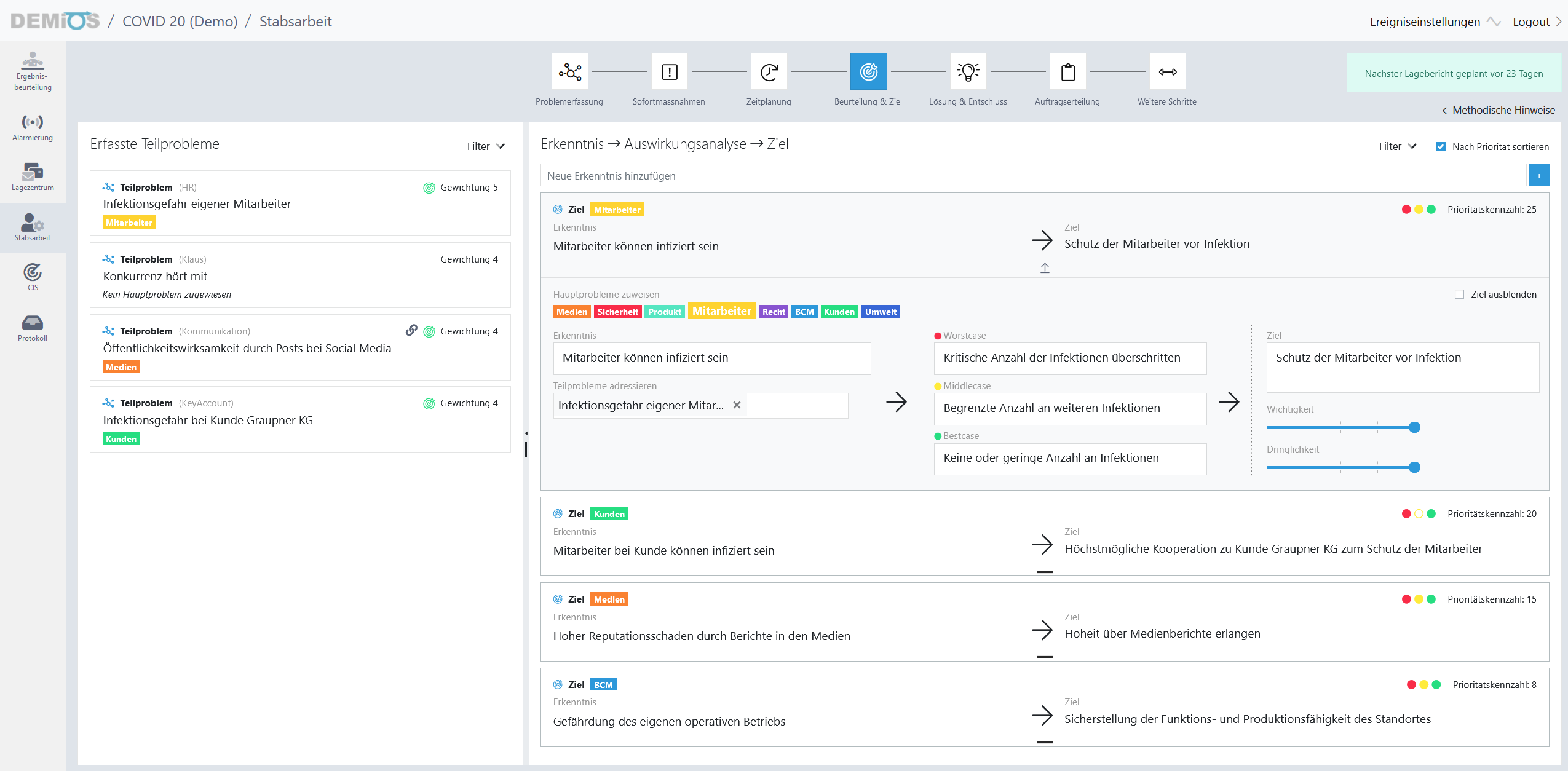To put it simply, a crisis is when nothing is the way it was or, rather, the way it should be. This applies both to exceptional events such as the current COVID-19 crisis and especially to “smaller” and more time-limited events. These are highly escalated, exceptional situations that cannot be handled by the normal organization and for which even the operationally oriented business continuity management (BCM) does not offer a complete solution. This is because a crisis is not exclusively about restoring normal operations, but much more about limiting the overall business damage, in a situation where a solution is initially unknown. And it is precisely this aspect that is often overlooked in the initial reactive and “noisy” phase of an incident response.
In the current COVID-19 crisis, the crisis staffs of many companies and organizations have been meeting for months, responding to the ever-changing state and coming up with solutions in what is largely an unknown situation. The basic lessons learned1 range from insufficient pandemic plans, the challenges of staff work from home, the simultaneous occurrence of ransomware attacks, the challenge of decision-making, to the demands of international coordination and a massive push for digitization with the introduction of MS Teams, SharePoint, Office 365 and similar tools.
During the ongoing Corona crisis, there was very little willingness among many companies to make fundamental changes in their crisis management. With the hope that the current situation will soon come to an end, there is a growing willingness to learn the right lessons from the experience of the past months. An unbiased assessment should now lay the foundation for a sustainable improvement in preparation for future challenges in the field of continuity and crisis management. Numerous weak points must be identified, assessed and eliminated with the appropriate measures.
For the insuring industry, this initially means optimizing existing insurance contracts. In the companies, a holistic view is required that encompasses issues of insurance management, supply chain management, corporate security, continuity and crisis management. Change processes are required, which do not even stop at classic departmental thinking. The buzzword “resilience management”, which has been discussed for some time, is experiencing a new blossoming. Demands for a reorientation of corporate security are being heard. A comprehensive understanding of risk management is stimulating internal discussion.
What impact does this discussion have on the area of crisis management that is focus here? The fundamental requirement for crisis management is to create a situation in which strategic decisions can be made in a structured process, taking advantage of the challenges and opportunities of digitization in the future.
One of the biggest challenges in staff work is the decision-making process. The challenges of decision-making are often underestimated. Poor decision-making makes an already difficult situation even worse. At its very core, crisis management involves responding well to a highly escalated situation based on the best available information and using it to implement decisions, thereby controlling the organizations response to the event and minimizing the impact of the event2. This decision-making process represents the flowing organization of the crisis management teams work and is reflected in the so-called “leadership rhythm”.
But do these measures derived from classical doctrine meet the requirements for successful crisis management? Aren’t the acting employees and their interaction decisive for successful management? What are the challenges for “leadership” in a highly dynamic situation? What special demands are placed on the members of a crisis team? These aspects have received little attention in the past<sup>3</sup> but are critical to the success of crisis team operations. These aspects will be addressed in depth based on the preliminary work in the British Crisis Management Standard and in the future ISO CD 22361.

What are the manifestations that characterize a crisis? Chaos typically reigns, especially in the early days. Usually without warning, the crisis occurs and abruptly changes the conditions for the affected companies. Previous rules and processes no longer apply. The key executives must first come together to work in a coordinated and structured manner in one direction. All this happens under immense pressure, because the time factor is crucial for success. If you wait too long, you minimize your room for maneuverability and your chances of getting out of the situation in one piece.
But defining rapid and, above all, correct measures for globally networked systems is easier said than done. Because we all know excessive stress paralyzes the ability to think and analyze. Under pressure, spontaneous reactions often occur that are rather counterproductive or even turn a budding crisis into a major one. In addition, the numerous organizational measures require a high level of human resources.
At this point, the combination of methodology and technology can provide serious support. The consistent methodical approach of strategic decision-making, applied as a “leadership rhythm” in numerous staffs in the field of civil defense or the military, provides the necessary orientation in the structured sequence. If this leadership process as a structural element in crisis management is embedded in a program tailored to it, a support tool is created that provides decisive relief for the crisis staff and situation center.

The problem points in classic crisis management often include the accompanying administrative processes, such as placing assignments, controlling assignments, writing minutes and gathering information. They are often very time-consuming and tie up disproportionate resources. This also includes the visualization of the situation, which is often not designed in such a way that all members of the staff really have a “common picture of the situation”, despite the great effort involved. And the loss of time until the staff is ready to act before its first meeting is often a serious problem point as well.
A modern crisis management application supports the crisis team in its work, i.e., it addresses these typical weak points of the classic crisis management process, structures orders and their controlling, and simplifies logging and the forwarding of information. In addition, it should help to enable interaction between the members of one or more staffs and provide everyone with a comprehensive overall picture of the situation in real time.
The solutions currently offered on the market differ in the technology used. A few years ago, local, database-based programs were developed, sometimes at great expense, which focused on the provision of documents or alerting processes within their own system architecture. They did not become established on the market.
In contrast, web-based alerting tools, with their universal access capabilities, are now widely used. The alerting software provides the very important prompt basic information for all those involved but only rudimentarily at best takes the structure-giving element of the subsequent management process and interaction into account. A crisis management application, however, must bring precisely these two elements together in a meaningful way. In addition, suitable interfaces should enable established and existing systems in companies to be used without media discontinuity. This means that established systems such as Office 365, SharePoint, virtual communication applications and data pools can be seamlessly integrated. This means that the workflow from the crisis team is routed directly to the employees without any loss of time. Response times thus increase decisively without additional training effort.

When introducing a crisis management application, some technical requirements have to be met, but these are usually present in modern companies today. The concrete need of the potential user should be recorded with a conceptual design workshop. Digitization solutions in a company are not an “off-the-shelf” product. Depending on the concrete wishes of the company and the status of the implementation of already existing tools, a rough concept for a future solution should be created as a result of the conceptual design workshop and then adopted.

In practice, at this point we as consultants experience the confrontation with the “all-in-one solution suitable for every purpose”. From our point of view, the understandable wish for a complete solution that covers everything cannot be fulfilled. We see the solution in the future-oriented integration of existing solutions or their adaptation to specific requirements, taking into account the latest web-based technologies. The aspect of “usability”, i.e., the use by untrained employees in a stressful situation, plays a major role. The desired solution is to remain in the tool environment in which the employees are accustomed to from their daily work as long as possible.

In addition, an analogous crisis management manual should exist in the company or be developed in parallel with the introduction. It is advantageous if its methodological approach and the web-based crisis management application go in the same direction, i.e., the structure of the documentation and the sequence in the tool follow the same methodological approach, the management rhythm. Typically, the analog manual is additionally stored in the application and can thus be consulted electronically at any time.
In crisis management, however, even with the use of a supporting tool and the best organizational foundations, the human factor with its individual qualities remains the decisive success factor. In this situation, it is particularly important that the acting persons are aware of their own behavioral patterns under stress and remain team players. Special demands are placed on the leader of a crisis team. The availability of a tool and working with it must therefore not represent an additional burden during crisis management. The user guidance should be designed to be self-explanatory and intuitive so that it can be grasped immediately even by an inexperienced person. The tool cannot eliminate management deficits, but it can reduce their consequences through its clear structure.
Despite all progress, even the best application will probably not solve crises autonomously for the time being, and so employees will continue to be the key factor in emergency and crisis organizations for coping with unforeseen events with high damage potential. In today’s volatile environment, companies are well advised to prepare organizationally and technically to manage such events. In the end, however, the most important step for success should not be forgotten, which is to “practice, practice, practice!”
Based on the requirements described in the article for a technical solution in the field of emergency and crisis management, the consulting company Verismo GmbH has developed the support tool DEMiOS. DEMiOS accompanies and controls the entire crisis management process, starting with the event recording, the assessment of the event with a view to the hazard and damage potential, the information and alerting management and ending with the actual crisis response work. DEMiOS draws on the proven management rhythm of the Swiss Civil Defense, which Verismo GmbH has adapted for use in commercial enterprises. In addition, the system offers integration into an existing IT system landscape.
In addition to product-specific training courses on DEMiOS, Verismo GmbH offers a wide range of further education and training measures at the company’s own Verismo Academy in Haßloch/Pfalz in the areas of risk, emergency and crisis management, among others.
1 See: Klaus Bockslaff, Grundlegende Erfahrungen der Krisenstabsarbeit der vergangenen zwölf Monate, in: s+s Report, Heft 1 / 2021, pages 53 – 57.
2 Unofficial translation of Crisis management – Guidance and good practice, BS 11200:2014, ch. 6.1. Based on this standard, the crisis management standard ISO 22361 is currently being developed at ISO.
3 A particularly noteworthy exception is the book by Laurent F. Carrel, Leadership in Crises, Zurich, 2010.
